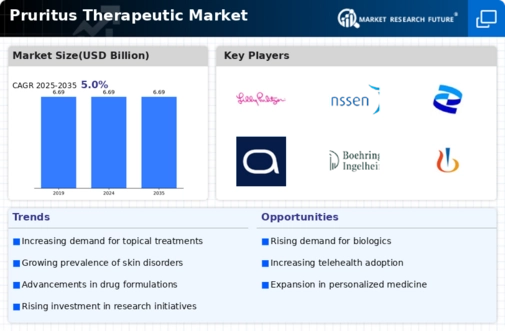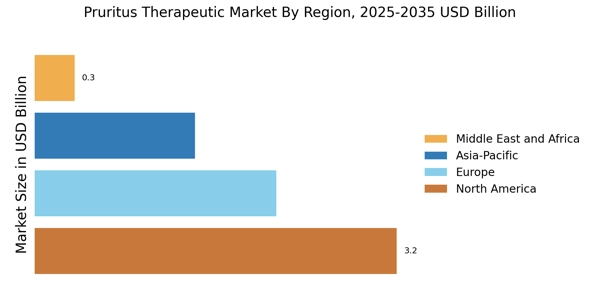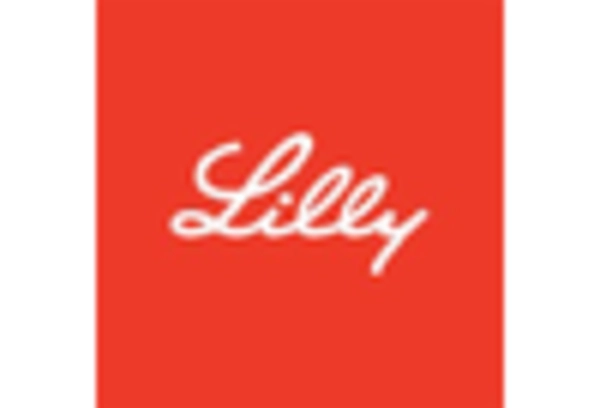Growing Awareness and Education
The growing awareness and education regarding pruritus and its impact on quality of life are pivotal drivers of the Pruritus Therapeutic Market. Healthcare professionals and organizations are increasingly emphasizing the importance of recognizing and treating pruritus effectively. Educational campaigns aimed at both patients and providers are helping to destigmatize the condition and encourage individuals to seek treatment. This heightened awareness is reflected in the rising number of consultations for pruritus-related issues, leading to increased prescriptions for therapeutic agents. Market data suggests that as more patients become informed about available treatment options, the demand for effective therapies will continue to rise. Consequently, the Pruritus Therapeutic Market is likely to benefit from this trend, as healthcare systems adapt to meet the needs of an informed patient population.
Advancements in Drug Development
Recent advancements in drug development technologies are significantly influencing the Pruritus Therapeutic Market. The introduction of biologics and targeted therapies has revolutionized treatment options for pruritus, particularly in chronic conditions. These innovative therapies are designed to specifically target the underlying mechanisms of itch, offering improved efficacy and safety profiles. Market data indicates that the biologics segment is expected to witness substantial growth, driven by the increasing approval of new drugs. Furthermore, the collaboration between pharmaceutical companies and research institutions is fostering the development of novel compounds, which may lead to more effective treatments. As a result, the Pruritus Therapeutic Market is likely to experience a surge in new product launches, enhancing treatment paradigms for patients suffering from pruritus.
Rising Incidence of Skin Disorders
The increasing prevalence of skin disorders, such as eczema and psoriasis, is a primary driver of the Pruritus Therapeutic Market. According to recent data, skin conditions affect millions of individuals worldwide, leading to a heightened demand for effective therapeutic solutions. This surge in skin disorders is attributed to various factors, including environmental changes and lifestyle choices. As a result, pharmaceutical companies are focusing on developing innovative treatments to address these conditions, thereby expanding their market presence. The growing awareness of skin health and the psychological impact of pruritus further contribute to the demand for therapies. Consequently, the Pruritus Therapeutic Market is poised for growth as healthcare providers seek to offer comprehensive treatment options for affected patients.
Integration of Telemedicine in Dermatology
The integration of telemedicine into dermatology practices is emerging as a transformative driver of the Pruritus Therapeutic Market. Telehealth services enable patients to consult with dermatologists remotely, facilitating timely diagnosis and treatment of pruritus. This trend is particularly beneficial for individuals in remote or underserved areas who may have limited access to specialized care. Market data suggests that the adoption of telemedicine is increasing, with many healthcare providers incorporating virtual consultations into their practice. This shift not only enhances patient access to care but also streamlines the management of pruritus, allowing for quicker adjustments to treatment plans. As telemedicine continues to gain traction, the Pruritus Therapeutic Market is likely to see an increase in patient engagement and adherence to treatment regimens.
Aging Population and Associated Health Issues
The aging population is a significant demographic factor driving the Pruritus Therapeutic Market. As individuals age, they often experience a range of health issues, including skin conditions that can lead to pruritus. The geriatric population is particularly susceptible to dry skin and other dermatological disorders, which can exacerbate itching. Market data indicates that the demand for pruritus treatments is expected to rise in tandem with the increasing number of elderly individuals. This demographic shift necessitates the development of targeted therapies that cater to the unique needs of older patients. As healthcare providers focus on improving the quality of life for the aging population, the Pruritus Therapeutic Market is likely to expand, driven by the need for effective management of pruritus in this demographic.


















Leave a Comment